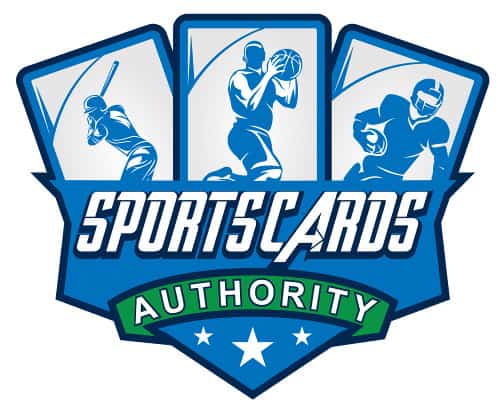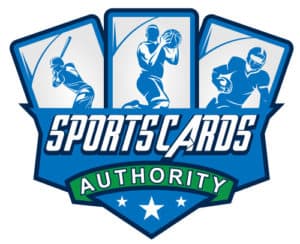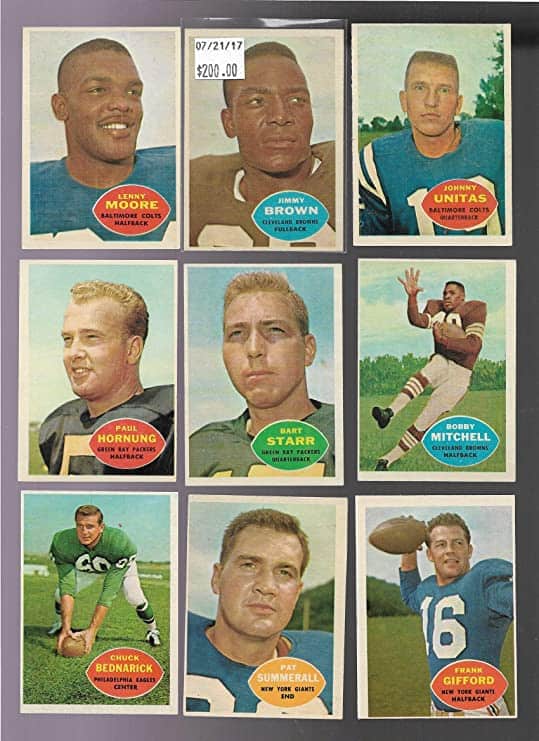The 132 cards in 1960 Topps Football cards are all different. Each is the typical size of 2-1/2 by 3-1/2 inches. Despite the checklists referring to it as a first and second series, it was released as a single series. Forrest Gregg’s rookie card (#56) is the sole noteworthy one. The collection lacks rookie cards, but it makes up for it in celebrity attraction, with the set’s cornerstones being Jim Brown (#23), Bart Starr (#51), and Johnny Unitas (#1). The collection also includes future Hall of Famers Paul Hornung (card #54), Frank Gifford (card #74), Bobby Layne (card #93), and Y.A. Tittle (card #113). The collection is notable for being the first to include Dallas Cowboys cards.
What Is The Best 1960, Topps Football Card?
A great budget-friendly vintage option is the 1960 Topps Football cards set. This fact is due to a few different factors. The biggest is that there isn’t a rookie card for a famous player. Due to the equal printing of every card in the set, there are no rare cards. The card paper also maintains its quality, making it simpler to assemble a set in EX condition or better. One of the more attractive sets of the time, thanks to the player’s image dominating the card’s environment due to the design’s simplicity.
10. Sam Huff #80
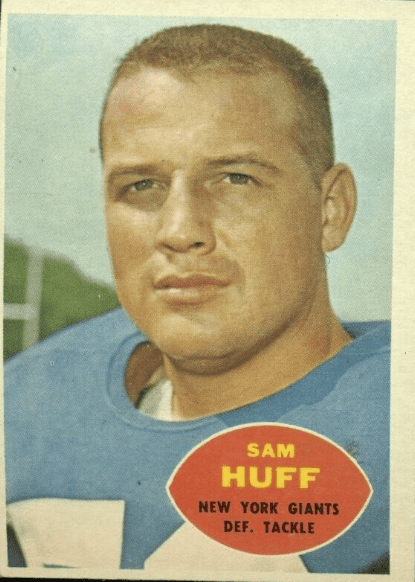
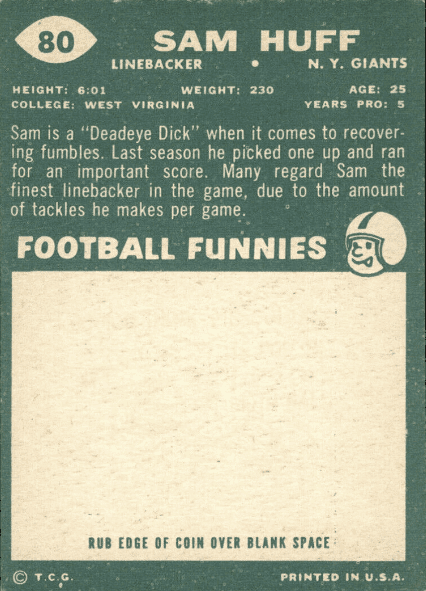
Images from 1957 Topps Baseball appear similar to those from 1960 Topps Football cards. The Sam Huff name, team, and position are displayed on a tiny football symbol in one of the bottom corners. The red colour is used to represent football. The card has a white border around it.
The layout of the cards’ backs is reflective of the 1959 Topps format. The card number is displayed as a football-shaped emblem, and Sam Huff’s name, team, and position are listed next to it. Below are two lines of statistics.
The Football Funnies feature, a cartoon hidden under a scratch-off surface, occupies the remaining space on the back of the cards. As expected, a scratched card has a lower value than an unscratched one.
Sam is an expert at picking up fumbles like Deadeye Dick. He grabbed one and sprinted for a significant touchdown. Because of how many tackles he makes every game, many people think Sam is the funniest linebacker in the league.
9. Redskins Team #132
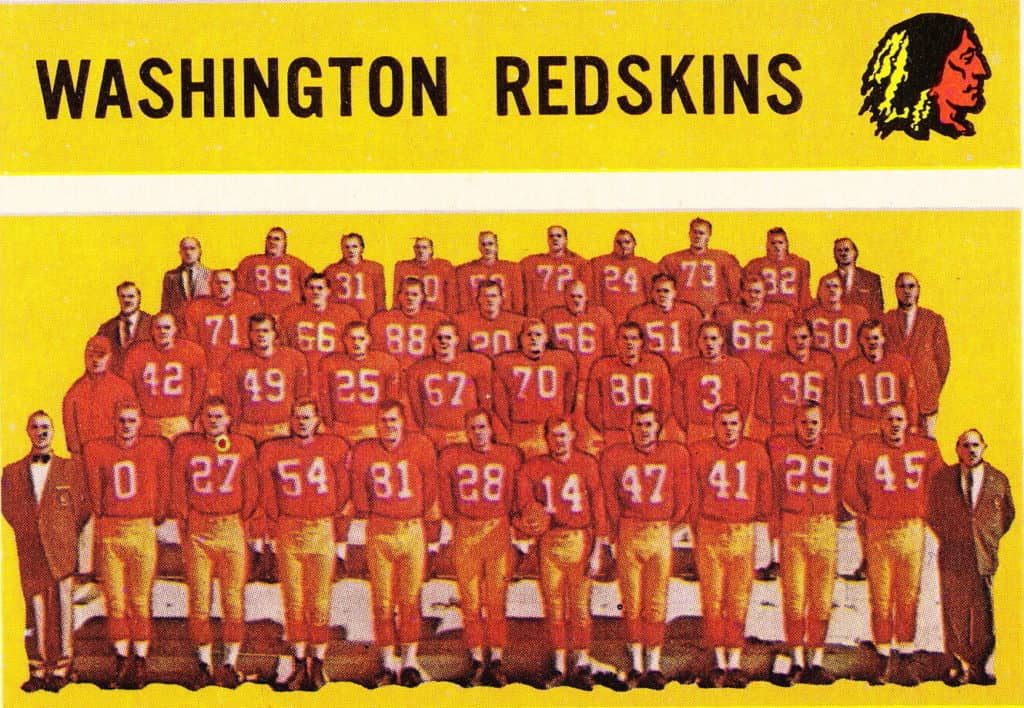
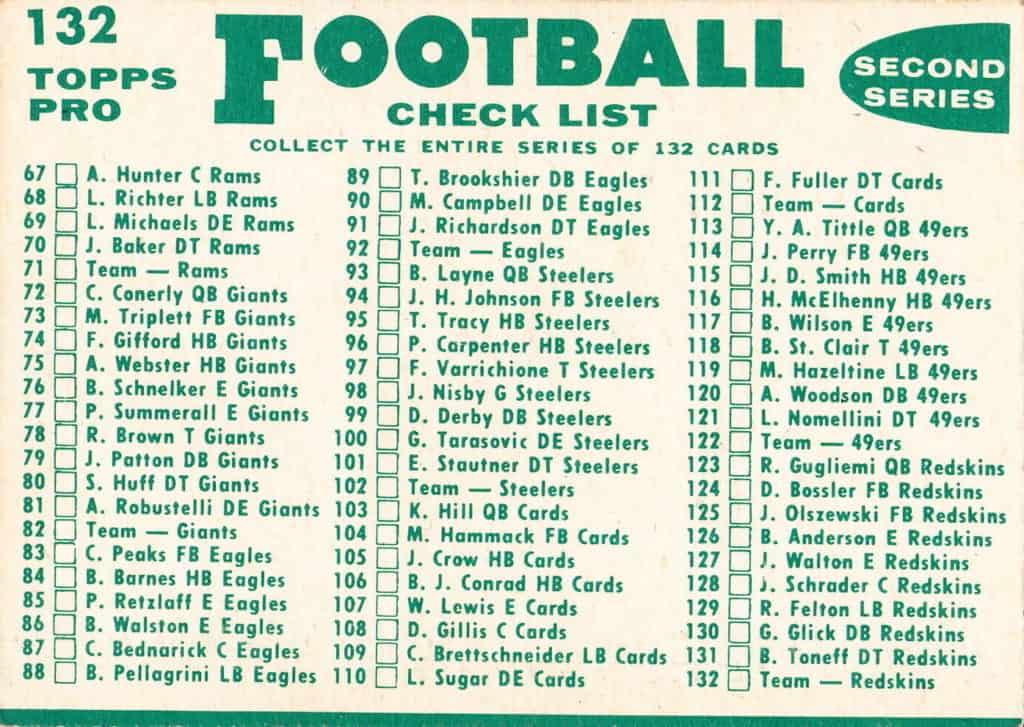
The front side of the card shows all the team members. Players are not organised according to alphabetical order, but the cards are numbered such that each team gets a section inside the set. Instead, the running backs are often put first, then the quarterback. Baltimore is first, and Washington is last in the alphabetical order of the cities’ teams. The first Cowboys cards are included in the set because Dallas was an expansion team.
Additionally, the Cardinals are now in St. Louis, their new home. The back of every club’s team photo card, except the Cowboys, has a checklist. The team card is the last in each team’s part of the deck.
8. Bobby Layne #93
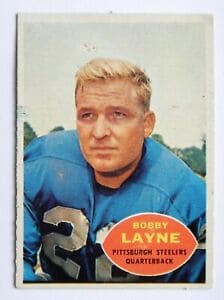
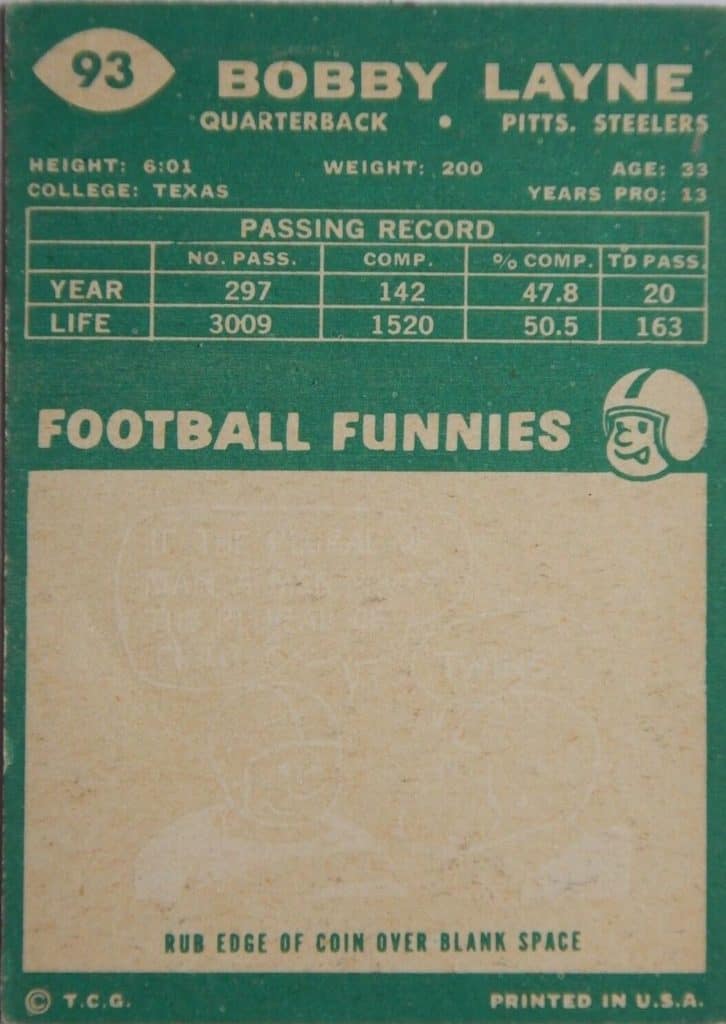
Images from 1957 Topps Baseball appear similar to those from 1960 Topps Football Cards. Bobby Layne’s name, team, and position are displayed on a tiny football symbol in one of the bottom corners. Orange colour is used to represent football. The card has a white border around it.
The layout of the cards’ backs is reflective of the 1959 Topps format. The card number is displayed as a football-shaped emblem, and Bobby Layne’s name, team, and position are listed next to it. A defined region with year and lifetime data is underneath it. The Football Funnies feature, a cartoon hidden under a scratch-off surface, occupies the remaining space on the back of the cards. As expected, a scratched card has a lower value than an unscratched one.
While still at UT, Bobby Layne was selected as an All-American and was considered for the Heisman Trophy. The Chicago Bears selected Layne as the third overall choice in the 1948 NFL Draft. Layne participated in 15 seasons of professional football with the Bears (1948), New York Bulldogs (1949), Lions (1950–1958), and Pittsburgh Steelers (1958-1962). He guided the Lions to three NFL League Championships and four NFL championship games (1952, 1953, 1957). Bobby Layne had a successful career with 26,768 passing yards, 196 touchdowns, 243 interceptions, and 372 total points scored over 15 years.
7. Y.A. Title #113
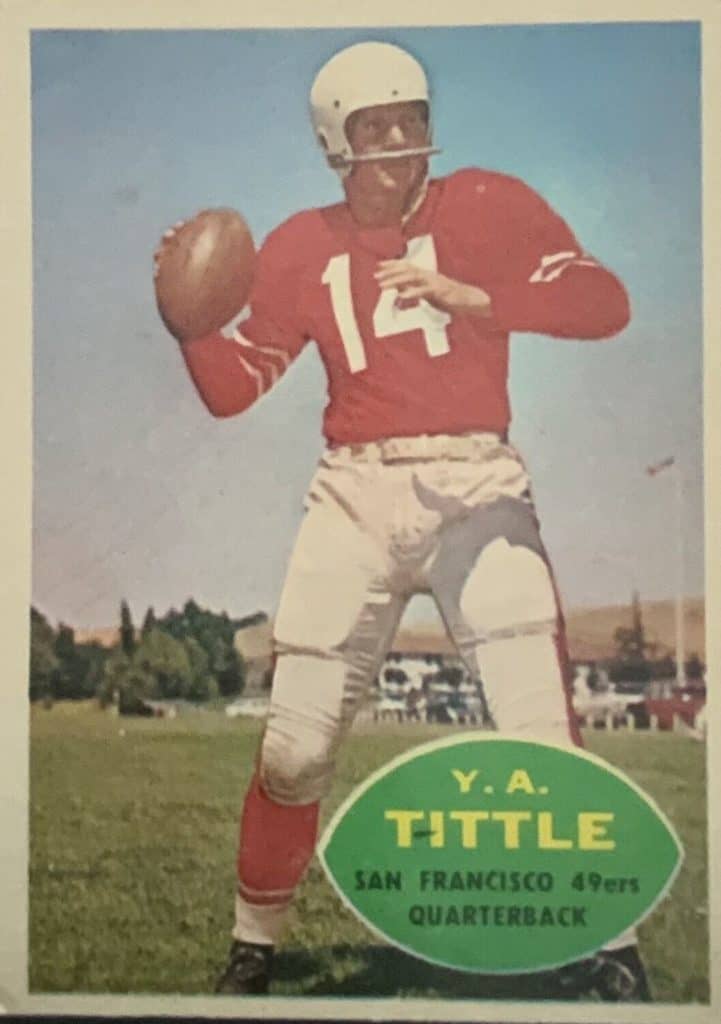
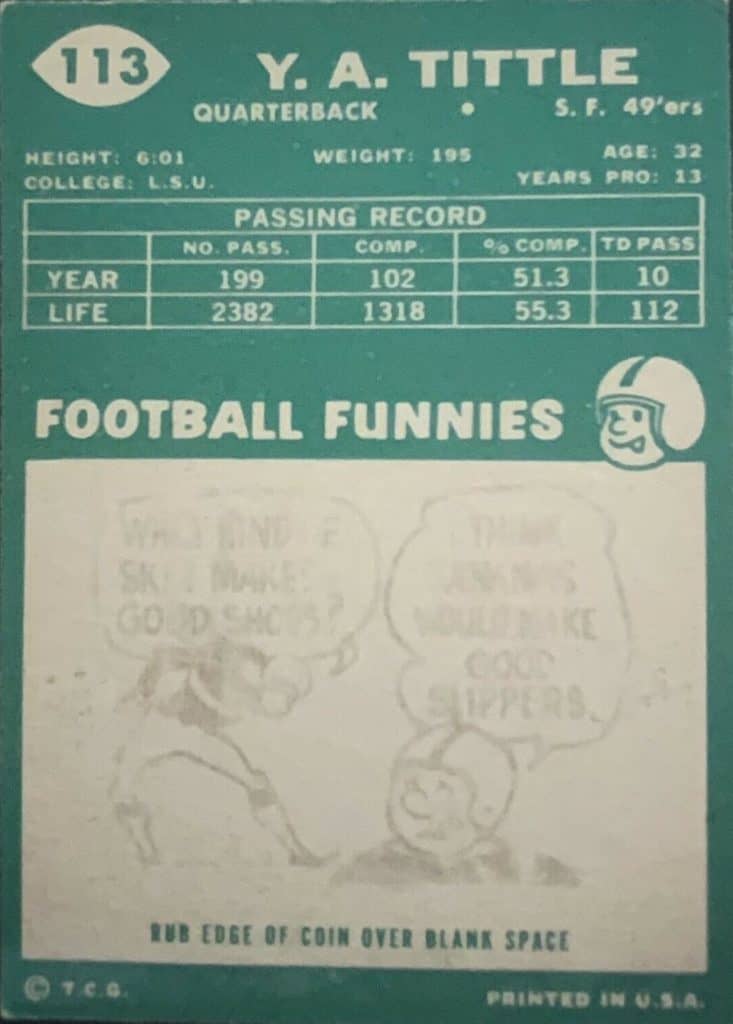
Images from 1957 Topps Baseball appear similar to those from 1960 Topps Football. The Yelberton Abraham’s name, team, and position are displayed on a tiny football symbol in one of the bottom corners. The green colour is used to represent football. The card has a white border around it.
The layout of the cards’ backs is reflective of the 1959 Topps format. The card number is displayed as a football-shaped emblem, and Yelberton Abraham’s name, team, and position are listed next to it. A defined region with year and lifetime data is underneath it. The Football Funnies feature, a cartoon hidden under a scratch-off surface, occupies the remaining space on the back of the cards. As expected, a scratched card has a lower value than an unscratched one.
Yelberton Abraham “Y.A.” Tittle (October 24, 1926 – October 8, 2017) was a quarterback for the All-America Football Conference’s Baltimore Colts in the 1948 NFL Draft. Title competed against Charlie Conerly in New York, Frankie Albert and John Brodie in San Francisco, and Tittle throughout his career for the starting quarterback position. He received three other NFL MVP awards (1961-1963). He was selected for three NFL Pro Bowls and seven NFL All-Pro First Teams.
6. Frank Gifford #74
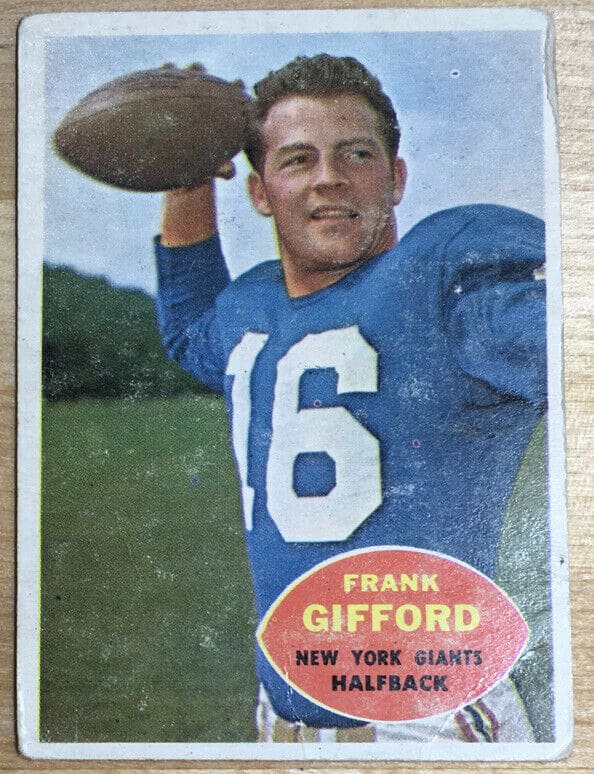
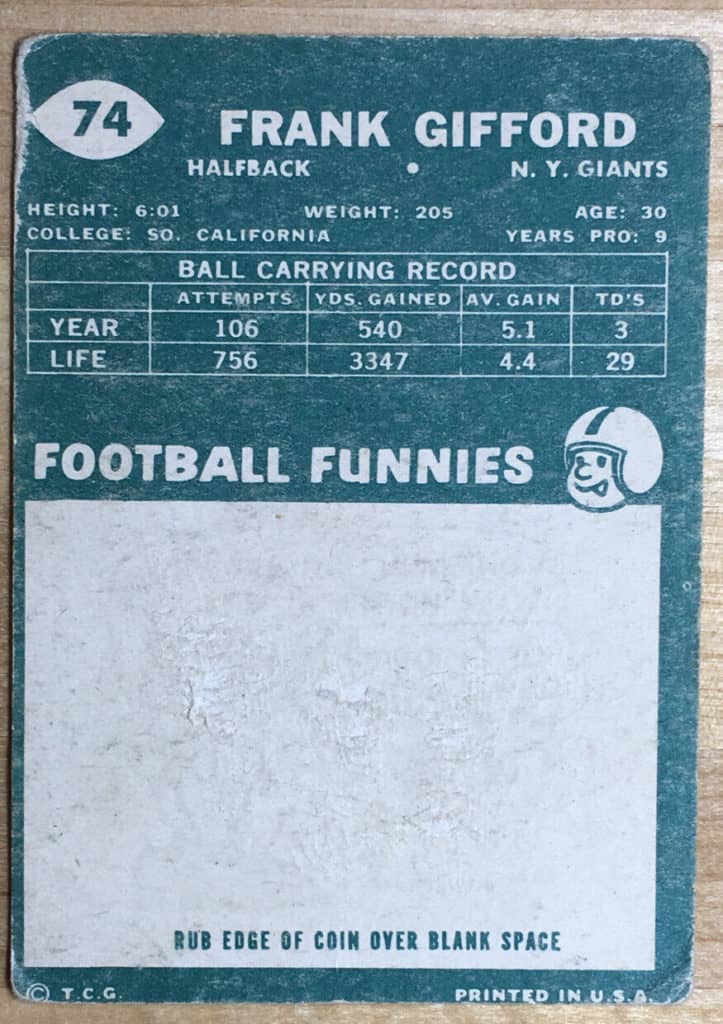
Images from 1957 Topps Baseball appear similar to those from 1960 Topps Football. Frank Gifford’s name, team, and position are displayed on a tiny football symbol in one of the bottom corners. Orange colour is used to represent football. The card has a white border around it.
The layout of the cards’ backs is reflective of the 1959 Topps format. The card number is displayed as a football-shaped emblem, and Frank Gifford’s name, team, and position are listed next to it. A defined region with year and lifetime data is underneath it. The Football Funnies feature, a cartoon hidden under a scratch-off surface, occupies the remaining space on the back of the cards. As expected, a scratched card has a lower value than an unscratched one.
The New York Giants selected Frank Gifford with the first pick in the 1952 draught. He was able to play defensive back, run, pass, catch, and return kicks and punts. Frank played two ways in 1953 when one-platoon specialists were the norm. He led the Giants to a league title in 1956 and was named the NFL’s Most Valuable Player that year. Playing three separate positions—first as a defensive back, then as an offensive halfback, and finally as a flanker in 1964—he was selected to the Pro Bowl.
5. Forrest Gregg RC UER #56
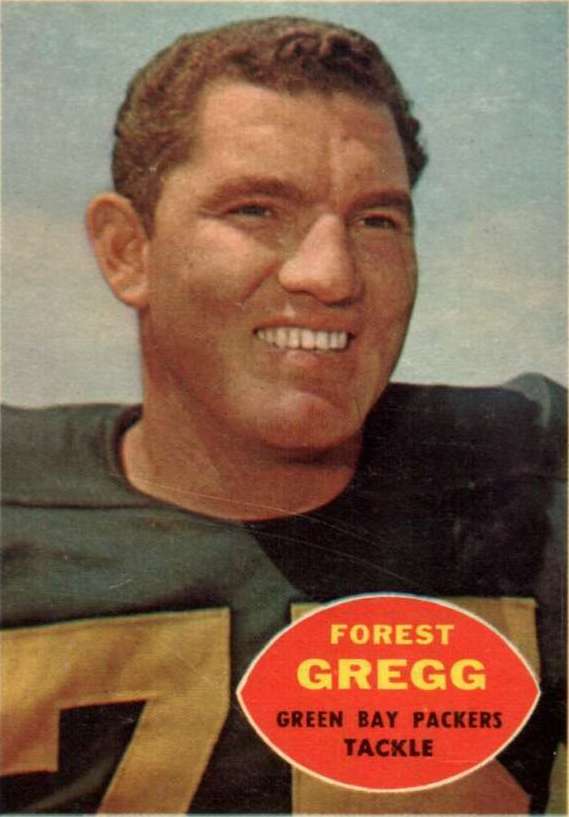
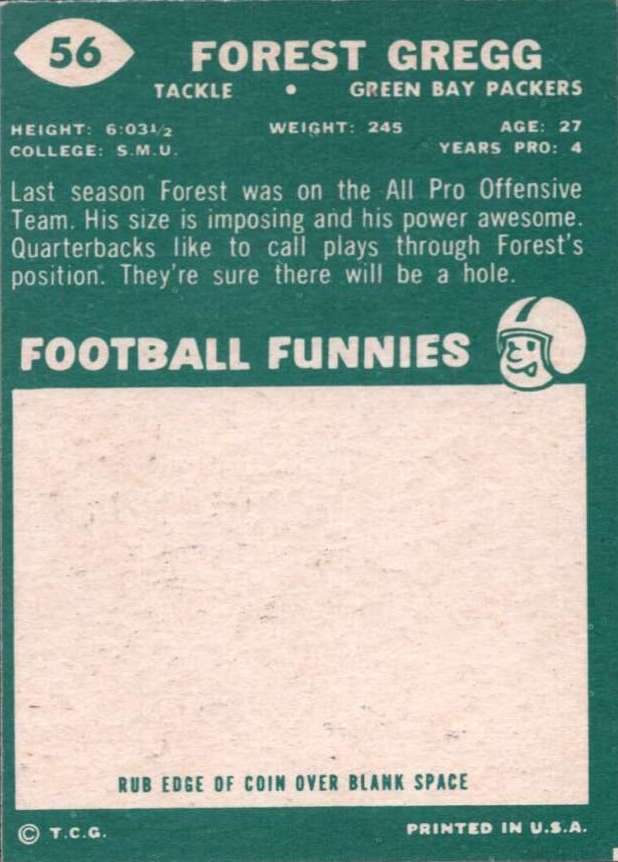
Images from 1957 Topps Baseball appear similar to those from 1960 Topps Football Cards. Forrest Gregg’s name, team, and position are displayed on a tiny football symbol in one of the bottom corners. The orange colour is used to represent football. The card has a white border around it.
The layout of the cards’ backs is reflective of the 1959 Topps format. The card number is displayed as a football-shaped emblem, and Forrest Gregg’s name, team, and position are listed next to it. Below are two lines of statistics. The Football Funnies feature, a cartoon hidden under a scratch-off surface, occupies the remaining space on the back of the cards. As expected, a scratched card has a lower value than an unscratched one.
Forest was a member of the All-Pro Offensive Team last year. His strength and size are astounding. Plays are frequently called through Forests’ position by quarterbacks.
4. Paul Hornung #54
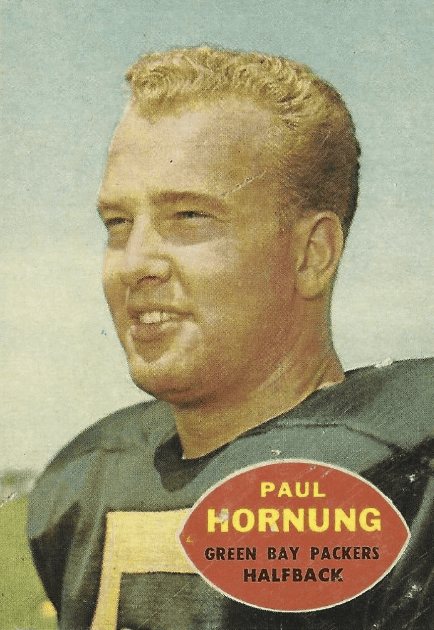
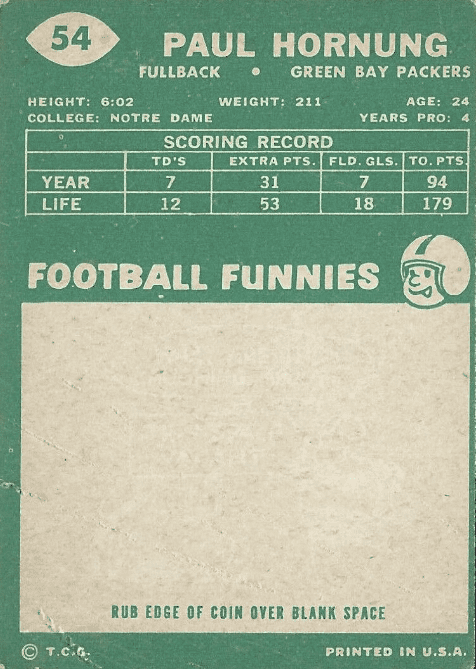
Images from 1957 Topps Baseball appear similar to those from 1960 Topps Football. Paul Hornung’s name, team, and position are displayed on a tiny football symbol in one of the bottom corners. The orange colour is used to represent football. The card has a white border around it.
The layout of the cards’ backs is reflective of the 1959 Topps format. The card number is displayed as a football-shaped emblem, and Paul Hornung’s name, team, and position are listed next to it. Below are two lines of statistics. The Football Funnies feature, a cartoon hidden under a scratch-off surface, occupies the remaining space on the back of the cards. As expected, a scratched card has a lower value than an unscratched one.
Between 1959 and 1966, Paul Hornung was a member of the Green Bay Packers, helping them to four NFL titles and the Super Bowl in 1966. With 94, 176, and 146 points, Paul was the NFL’s top scorer in 1959. Paul earned his second straight spot on the NFL All-Pro First Team in 1961, scored ten touchdowns, scored 15 field goals, and scored 41 extra points. He also received the NFL Bert Bell Award for Player of the Year.
3. Johnny Unitas #1
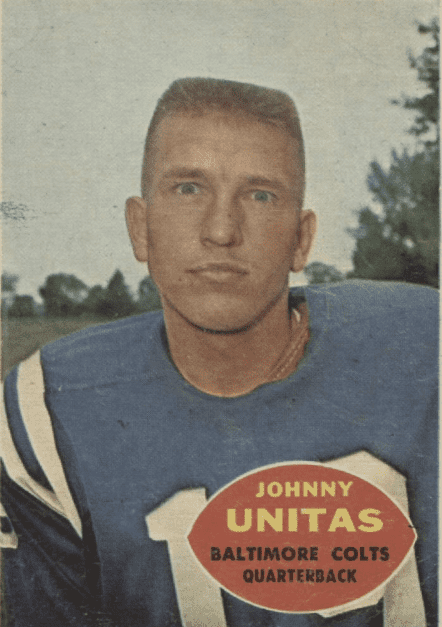
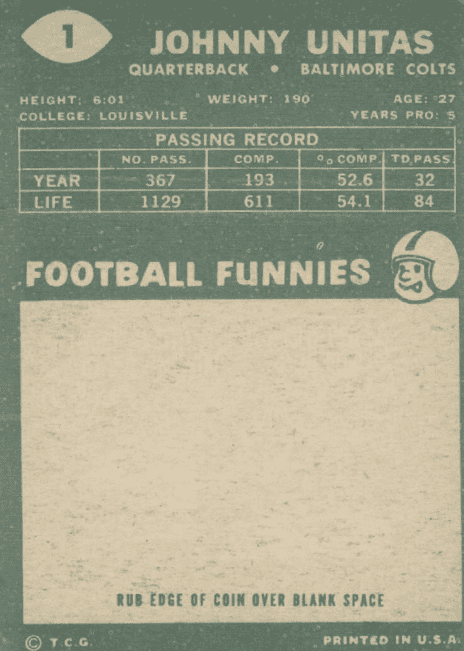
Images from 1957 Topps Baseball appear similar to those from 1960 Topps Football cards. Johnny Unitas’s name, team, and position are displayed on a tiny football symbol in one of the bottom corners. Orange colour is the colour used to represent football. The card has a white border around it.
The layout of the cards’ backs is reflective of the 1959 Topps format. The card number is displayed as a football-shaped emblem, and Johnny Unitas’s name, team, and position are listed next to it. A defined region with year and lifetime data is underneath it. The Football Funnies feature, a cartoon hidden under a scratch-off surface, occupies the remaining space on the back of the cards. As expected, a scratched card has a lower value than an unscratched one.
Johnny Unitas completed 18 years with the San Diego Chargers and the Baltimore Colts (1956–1972). (1973). He accumulated 40,239 throwing yards on 2,830 pass completions in 5,186 attempts before retiring as the offensive leader in most categories. He completed 290 passes for touchdowns and 253 interceptions, scoring 78 points and 13 running touchdowns. In 1979, Johnny Unitas became a member of the Pro Football Hall of Fame.
2. Bart Starr #51

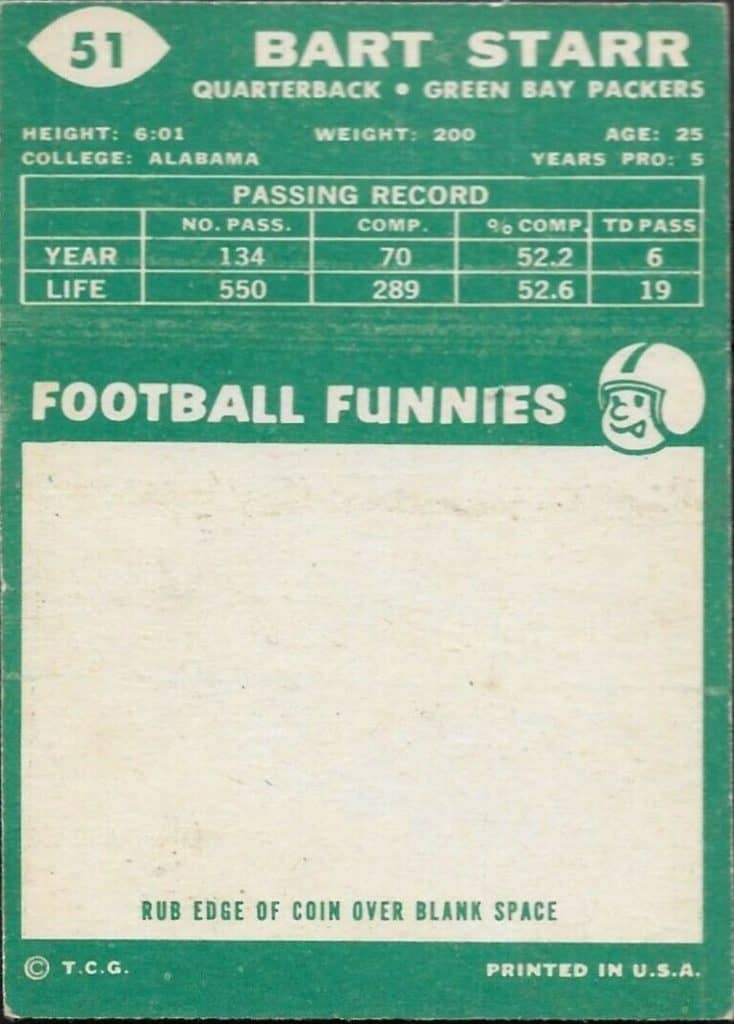
Images from 1957 Topps Baseball appear similar to those from 1960 Topps Football. Bart Starr’s name, team, and position are displayed on a tiny football symbol in one of the bottom corners. The green colour is the colour used to represent football. The card has a white border around it.
The layout of the cards’ backs is reflective of the 1959 Topps format. The card number is displayed as a football-shaped emblem, and Bart Starr’s name, team, and position are listed next to it. A defined region with year and lifetime data is underneath it. The Football Funnies feature, a cartoon hidden under a scratch-off surface, occupies the remaining space on the back of the cards. As expected, a scratched card has a lower value than an unscratched one.
In the 17th round of the 1956 NFL Draft, the Green Bay Packers selected Bart Starr. he still won five NFL championships, including Super Bowls I and II, and was awarded the MVP of both championship games. As the defending Super Bowl I winner, Bart had a great year in 1966, finishing with a completion rate of 62.2 percent and earning the league’s Most Valuable Player award. He was chosen for the NFL Pro Bowl four times and the 1966 NFL All-Pro First Team.
1. Jim Brown #23
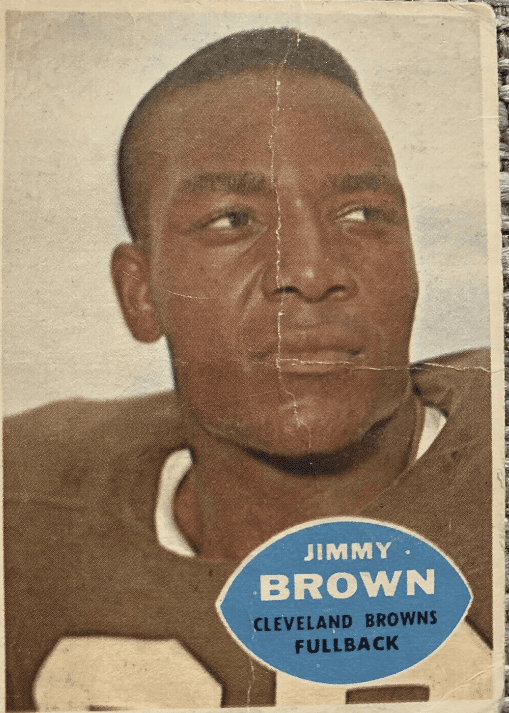
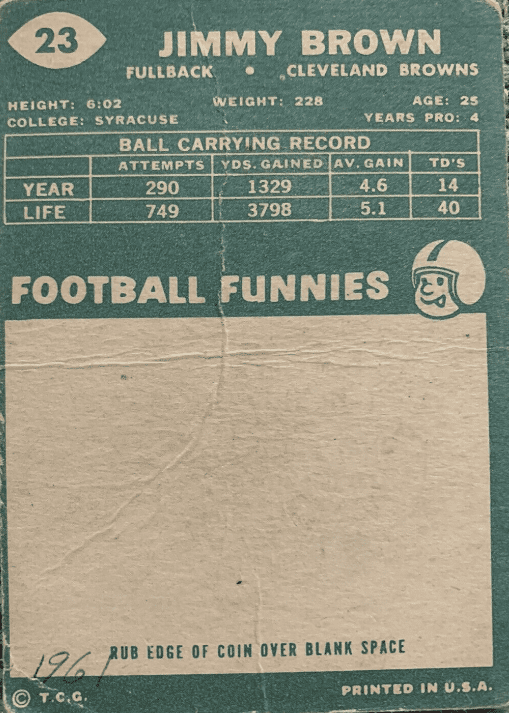
Images from 1957 Topps Baseball appear similar to those from 1960 Topps Football. Jim Brown’s name, team, and position are displayed on a tiny football symbol in one of the bottom corners. The blue colour is used to represent football. The card has a white border around it.
The layout of the cards’ backs is reflective of the 1959 Topps format. The card number is displayed as a football-shaped emblem, and Jim Brown’s name, team, and position are listed next to it. A defined region with year and lifetime data is underneath it. The Football Funnies feature, a cartoon hidden under a scratch-off surface, occupies the remaining space on the back of the cards. As expected, a scratched card has a lower value than an unscratched one.
One of the finest NFL players is primarily regarded as Jim Brown. He held the NFL record six times for running attempts and yards after contact during his nine-year career. He has been the league leader in all-purpose yards for most seasons. At the pinnacle of his game, Brown left the NFL after accumulating 12,312 running yards in 2,359 attempts and 106 touchdowns. After his playing days, Jim enjoyed a successful Hollywood career, making several film and television appearances.
Conclusion
Again for the second consecutive year, Topps put a photo of linebacker Jim Taylor from the Cardinals on a card meant to feature Jim Taylor from the Packers. This oversight was never fixed. Other documented faults include at least three cards with reverse photos, including Doug Atkins (#20), Bill Wade (#61), and Frank Varrichione (#97), as well as four cards with misspelt names, including Charlie Ane (#37), Chuck Bednarik (#87), Bob Pellegrini (#88), and Ralph Guglielmi (#123). On the reverse of Bill Anderson’s card (#152), he is referred to as Walt Anderson. Centring print imperfections and the delicate green borders on the back of the cards make it challenging to obtain 1960 Topps Football card sets in excellent condition.
